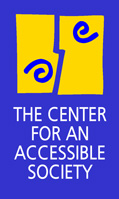
DISABILITY
ISSUES
INFORMATION
FOR
JOURNALISTS
ABOUT
THE CENTER
"Visitability" bill introduced in CongressJune 10, 2003 -- Rep. Jan Schakowsky (D.-Ill.) has introduced H.R. 2353 to require all single family homes receiving federal funds be built with a no-step entrance, "32" clearance doorways on the main level, and one wheelchair-accessible bathroom. "It defies logic to build new homes that block people out when it's so easy and cheap to build new homes that let people in," says Schakowsky. To see a copy of the bill, go to http://thomas.loc.gov and type in HR2353.
"Under current law," says Schakowsky, "95 percent of federally supported homes do not have to meet any accessibility standard. This creates unnecessary barriers for disabled veterans and other people with mobility impairments. It defies logic to build new homes that block people out when it's so easy and cheap to build new homes that let people in. Many states and localities have already incorporated visitability standards. This list includes Naperville, Bollingbrook, and Champagne, Illinois, Atlanta, Vermont, Texas, Kansas, Arizona and others."
Read Schakowsky's statement to Congress on visitability
Visitability"Visitability" has been a growing trend nationwide for the past ten years. The term refers to single-family housing designed in such a way that it can be lived in or visited by people with disabilities. A house is visitable when it meets three basic requirements:
"When someone builds a home, they're not just building it for themselves -- that home's going to be around for 100 years," Concrete Change founder Eleanor Smith told The New York Times. "These things hurt nobody -- and they help a lot of other people."
- at least one no-step entrance
- doors and hallways wide enough to navigate through
- a bathroom on the first floor big enough to get into in a wheelchair, and close the door.
"The visit-ability movement is based on the conviction that inclusion of basic architectural access features in all new homes is a civil and human right and improves livability for all," according to Visit-ability: an Approach to Universal Design in Housing, a publication by the Rehabilitation Engineering Research Center on Universal Design at The State University of New York, University at Buffalo.
Visitability first surfaced in the U.S. in 1986 in Atlanta, with the founding of the grassroots group Concrete Change. Founder Eleanor Smith recalls, "One day in 1986 I was driving around in Atlanta, Georgia, my home city, and I passed though a large development of new homes. As always, these homes had steps at every entrance. But very suddenly I looked at the houses differently. I thought, 'These homes could have all had access.' "
Concrete Change promotes the concept through its website at http://concretechange.home.mindspring.com and worked with the city of Atlanta to pass the nation's first visitability law, which required that all public housing be accessible. Atlanta now has over 500 single family homes with vistability features (photo online at http://concretechange.home.mindspring.com/laws.htm).
Visitability became more visible throughout the 1990s, as the concept picked up adherents, and the state of Oregon and a number of cities, including Chicago, Austin, TX and Urbana, IL, passed ordinances that mandated visitability features in single-family housing paid for with public money.
But in 2001 and 2002, visitability came to the forefront. In the spring, Naperville, Il., and Pima County, AZ made news by passing "visitability" ordinances (Naperville has since voted to scale back its ordinance). Finally, in the first federal recognition of the concept, the Inclusive Home Design Act, HR 5683, was introduced into Congress by Rep. Jan Schakowsky (D.-Ill.) in October.
L. A. Times reporter Bob Pool notes that before Santa Monica's ordinance will become reality, "a major obstacle must be overcome: negative public opinion from those who may fear that liberal Santa Monica is once again taking on a social crusade." Concrete Change members, who are familiar with the arguments, have posted a page of responses at http://concretechange.home.mindspring.com/responses.htm
More resources on visitability
More resources on visitabilityNote to readers: links to news articles may not work after a few weeks, as news media remove current stories to their archives. The link may take you to the archives section, where, for a fee, you can view the article.
Athough there's no legal requirement, the U.S. Dept. of Housing and Urban Development "encourages" visitability features in single-family housing built with federal dollars (http://www.huduser.org/publications/pubasst/strategies.html).
Temple University's Institute on Disabilities has information on visitability at http://www.temple.edu/inst_disabilities/iod_nofrm/publications/Accessibility/WhatIsVisitAbility.htm
SUNY/Buffalo maintains a listserv on visitability (with a searchable archive) at http://listserv.acsu.buffalo.edu/archives/visitability-list.html
Read stories about visitability in
The St. Petersburg Times
The Pittsburgh Post Gazette
The Arizona Star
The Chicago Tribune
The New York Times (registration required)More about state and local efforts on visitability can be found on the website of the AARP at http://research.aarp.org/il/inb48_homes.html
Read "On The Outside Looking In: Why Visitability and Universal Design Features Are So Important" by Kim Steele, online at http://www.copower.org/tools/kimhousingtxt.htm Another good article about visitability can be found at the website of the disAbility Resource Center in Everett, Washington. Read disability columnist Mike Ervin's National Public Radio commentary about Concrete Change's Eleanor Smith and Atlanta's visitable homes.
Sign up for a listserv on visitability (or read message archives) at http://listserv.buffalo.edu/archives/visitability-list.html